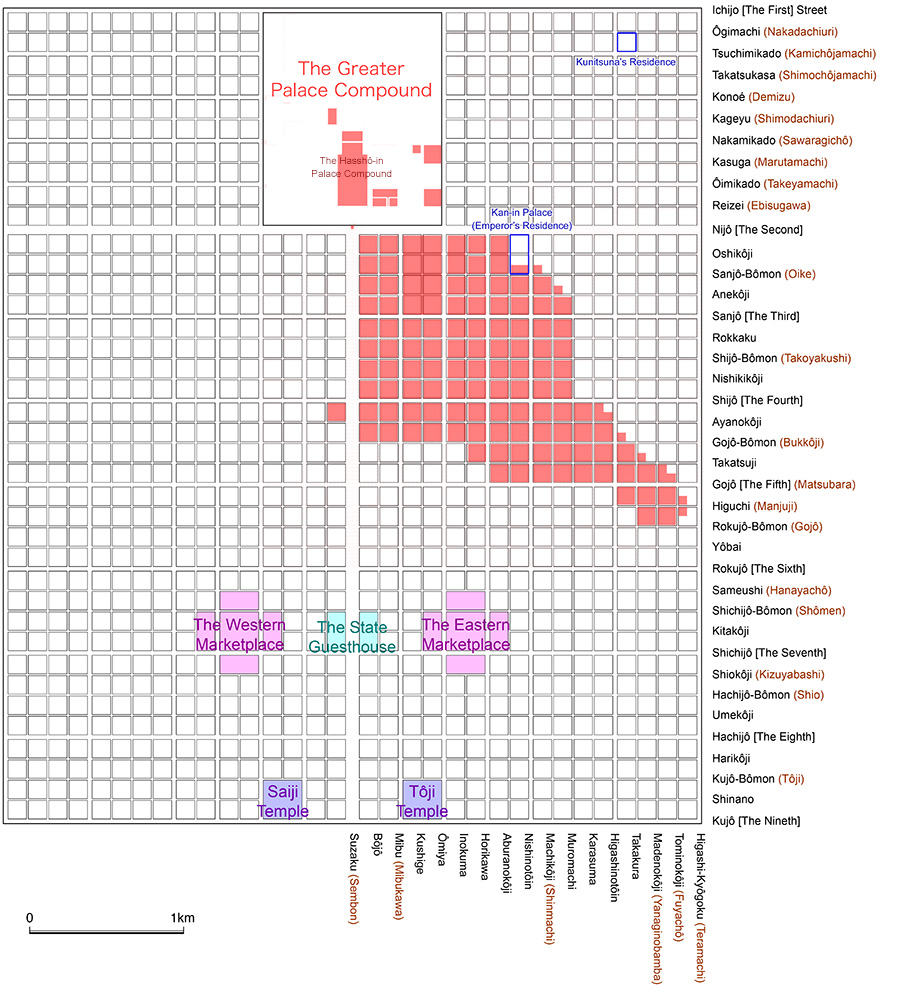28th day [4th month of the 3rd year of the Angen Era; May 27, 1177, Julian] : Clear weather. Around 8 p.m. I performed the ritual to end the mourning on the riverbed.
The princess also ended her mourning in this evening. Chamberlain to the princess [Kanezane’s son Yoshimichi] ended the mourning in front of her residence…
Around 10 p.m., a fire broke out in the northern direction. I heard that the fire started at Higuchi-Tominokoji. A servant reported that “the fire wasn’t yet controlled, and a great many houses in the Capital had burnt down. The fire is approaching the Kan-in Palace.” I was awakened and looked outside. I saw that the flames blazed even more fiercely and sparks were blown northwestward. Due to my sickness, I remained home and had a servant go to assess the situation. After returning, he reported that “the Kan-in Palace escaped the spread of fire. However the force of the fire is increasing, and the palace is under threat. Therefore, the Emperor has moved to (Fujiwara) Kunitsuna’s residence* at Ogimachi-Higashinotoin. [The Emperor used a palanquin, while the Regent moved on horseback, departing from the gate facing Nishinotoin Street]. The Empress also moved [using a carriage.]” I should investigate the detailed situation later on. The sudden departure of the Emperor amid the throes of agitated people must have been caused by a devil. People echo similar opinions.
Government buildings lost are as follows.
All the buildings in the Hassho-in Palace Compound, including Daigokuden, were lost.
Kaisho Gate, Oten Gate, Suzaku Gate,
Jingi-kan, Mimbu-sho, Shukei-ryo, Shuzei-ryo,
Shikibu-sho, Shingon-in, Shusui-shi,
Daizen-shiki, Daigaku-ryo (University), Kangaku-in.
Houses of the court officials lost are as follows.
Regent (Fujiwara Motofusa) [Nishikikoji-Omiya]
Minister of the middle (Taira Shigemori)
Minamoto Dainagon (Sadafusa) [in the West City; the above three were absent from their house]
Dainagon of the second rank [Sanjo-Nishinotoin]
Chugu-daibu (Fujiwara Takasue)
Chujo of the second rank [the above two are at Shijo-Omiya; they were in their houses]
Fujiwara Dainagon [Sanjo-Aburanokoji]
Fujiwara Chunagon [Ayanokoji-Nishinotoin]
Betto [Sanjo-Horikawa]
Minamoto Chunagon (Yorimasa) [Sanjo-Inokuma]
Horikawa Saisho [Ayanokoji-Horikawa]
Omiya Gonnodaibu [in the West City; he doesn’t live there]
Sadaiben [Rokkaku-Omiya]
Gojo Dainagon [accomodation at Nijo-Aburanokoji]
The above 14 court officials suffered from the fire. The number of the noblemen and commoners who suffered is uncountable. The damaged areas have been specified as Tominokoji Street to the east, Rokujo (The Sixth) Street to the south, Suzaku Street to the west, and the Greater Palace Compound to the north. This is an unprecedented disaster. Amid the flames, many whirls** occurred, which caused serious damage to people. There has never been a fire so great that broke out from the southern side of Gojo (The Fifth) Street and spread to the Hassho-in Palace Compound. The fire situation, which is still not under control, is out of the ordinary. In these days, fires, robberies, and revolts frequently occur, and the lives of people of all classes including priests and the secular are thrown into disturbance. These are really symptoms of the degenerate age, unchangeable by human ability. Even astronomical anomalies occur frequently and laws remain untouched, thereby causing disasters. This is not right. Lately, Mars has stayed within the Taiwei constellation*** for several days. Since Mars is the fire spirit and the Taiwei refers to the Imperial Palace, the flowerful capital should have been destined to be burnt to ashes. My late father used to say that astronomical anomalies are omens of disasters, so the problems should be coped with quickly. The words of an ancient sage suggest that misery is the result of the moral deterioration of the people.
— From Gyokuyo by Kujo Kanezane
* Fujiwara Kunitsuna’s residence was at the place where today’s Kyoto Imperial Place is located. After the provisional Imperial Palace (Satodairi) had been transferred many times within Kyoto, the Imperial Palace was fixed at today’s location.
** Tsujikaze. This seems to be a very early record mentioning fire whirls.
*** Leo and Virgo for the zodiac.
 |
| Illustration by Fumi Kashimura |
